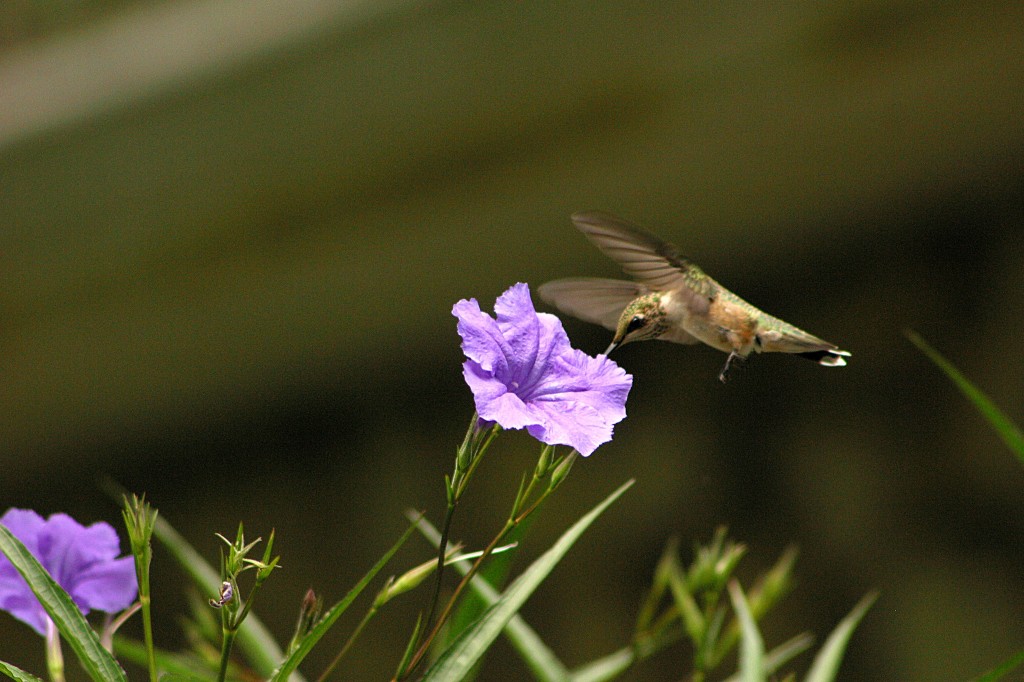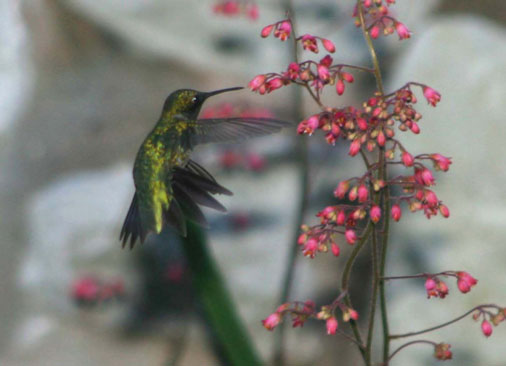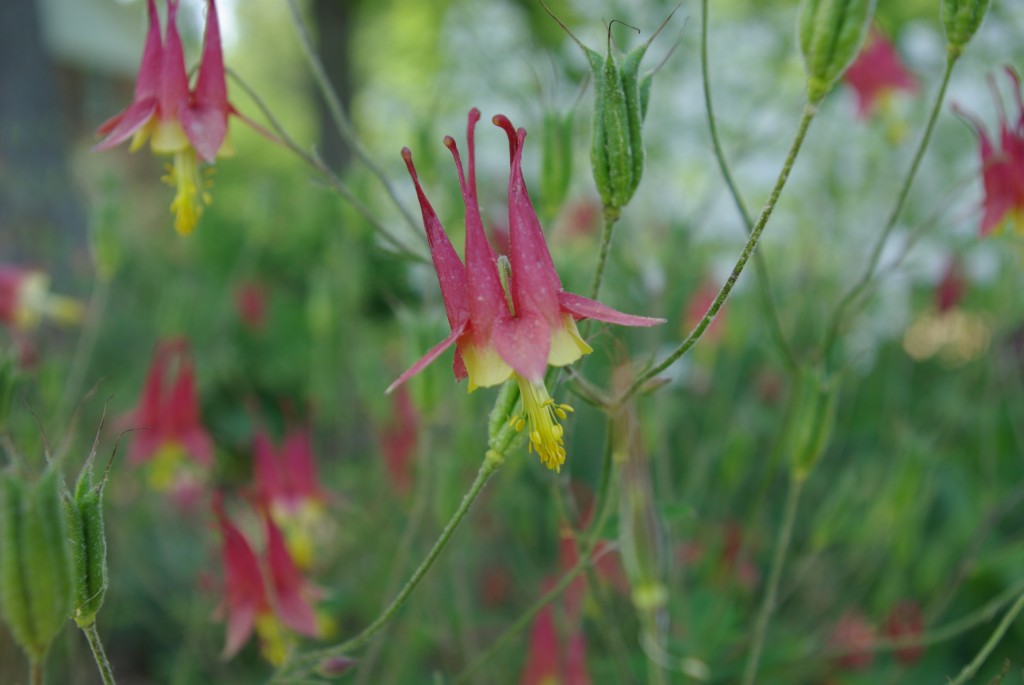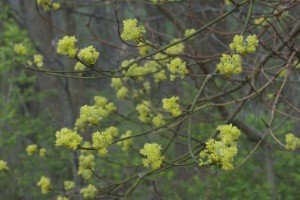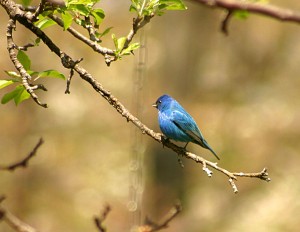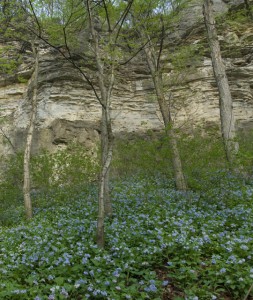The Hummers are Coming and Spring is a’hummin!
Ruby-throated hummingbirds will return to the bluff lands of Monroe, St. Clair, and Randolph Counties in April. They usually arrive the third week of the month.
The little gems cross the Gulf of Mexico twice each year, taking about 18-20 nonstop hours for each 500-mile, over-water crossing. Each bird travels alone (they don’t ride on the backs of other birds!). They spend the winter months in southern Mexico or Central America; most stay here from mid-April to early September.
The males have the ruby throats; females and juveniles are white-throated. At 3 ½ inches in length, they are just about as long as the middle toe of our bald eagles. They weigh slightly less than a penny. They beat their wings 100 times per second and have an average flight speed of 30 mph; in aerial courtship dives, males attain speeds of 60 mph.
A hummingbird’s heart beats about 1200 times per minute. With such a high-energy metabolism, hummingbirds consume food at an enormous rate. If humans were required to sustain such a high-energy lifestyle, they would have to eat 250 quarter-pound hamburgers a day! Hummers are attracted to nectar-producing flowers, with red, orange and pink flowers their favorites. In addition, hummingbirds eat large numbers of small insects, scooping them up midair, on the fly.
Hummingbird nests, built by the females, are about the size of a half dollar and resemble a knot on a limb. Females lay two white eggs, each egg the size of a peanut. Females may have two or, rarely, three clutches per year. After two weeks of incubation, newly hatched hummers have 2-3 weeks of nest life. Then the juveniles will join their parents at your hummingbird feeders.
If you feed hummingbirds, take several precautions. The standard solution for feeders is one cup of white sugar to four cups of water. Never use honey, red dye or artificial sweeteners — these may be fatal to the birds. During hot summer months change the feeders every 2-3 days to prevent spoilage. In the fall, leave your feeders out at least two weeks after you’ve seen the last bird at your feeder — late migrants need the food for their journey and sometimes stragglers still will be moving south into November.
Just about the time our hummers arrive, one of their favorite nectaring flowers
begins blooming. Columbine grow in the woods, and along shaded limestone cliffs and roadways of the bluffs. Their distinctive nodding flowers, with five red sepals, five yellow petals and numerous yellow stamens, make them easy to spot, and they are common throughout the bluffs.
Yellow bellwort also will bloom in April. The flowers are drooping, an inch and a half long, with six yellow petals. The stems pierce the leaves giving an appearance of leaves carefully sewn onto the stems by perfectly placed baste stitches. Bellworts are scattered in the bluffs’ moist hollows and along shady roadways. Early settlers cooked the leaves as greens and ate the upper stems as a substitute for asparagus.
Spicebush, scattered throughout our rich woodlands, began blooming in mid-March and will continue through mid-April. Its lemon-scented tiny yellow flowers on leaf-bare branches make it a standout for discovery. The caterpillars of our spicebush swallowtail butterflies require it as their principal food source. Native Americans used just about every part of the plant for a vast repertoire of medicines. Its red berries, which ripen in August-September, were used by early settlers as a substitute for allspice in cooking and baking.
By mid-April, many migratory songbirds will begin to move into and through our bluffs. Eastern Phoebes — back with us since March — often return to the same nesting spots year after year. This site fidelity was first shown by John James Audubon when, in 1805, he happily noted the return to the same site of two phoebes, still tagged with the silver threads he had placed on their legs the previous fall. Audubon’s experiment is the first known example of bird banding in the U.S.
Phoebes will be joined by some of the most colorful and tuneful birds in the Americas. Blue Grosbeak, Rose-breasted Grosbeak, and Indigo Buntings, members of the same subfamily as our resident Northern Cardinals, all return here in April. The strikingly colored male Rose-breasted Grosbeak was nicknamed “cutthroat” because of the bright pink bib, giving the appearance of blood staining his white belly, which contrasts with his black hood and back. Like their cardinal “cousins,” both grosbeaks have large, heavy bills — as indicated by their names derived from the French word “gros” for “big.” Male
Indigo Buntings, as the name implies, are bright blue, but the females are so drab — plain, little, brown birds — they seem almost a separate species. Indigo Buntings are notable both for their numbers, for in much of the Eastern U.S. they are the most numerous summer songbird, and for their daily songs which will continue well into the fall, long after other birds have stopped singing.
Many people consider the flute-like notes of thrushes to be the finest bird songs. Several species of thrush will migrate through our area, stopping to rest, eat and sing, but only one, the Wood Thrush, will stay and breed here. Closely related to American Robins and Eastern Bluebirds, this reddish-brown thrush sports dark spots on the white of its throat, breast and sides. The loud, liquid sound of its three-to-four note phrases, ending in complex trills, adds a serene note to our forest mornings.
Flashing orange and black, Baltimore Orioles sometimes will come to nectar at fruit feeders and often will construct their distinctive bag-shaped hanging nests in shade trees in towns. The slightly smaller Orchard Oriole also nests in our area. Males are a deep chestnut-red above and below with a black hood; females are dull olive above and greenish-yellow below with two white wing bars. Orioles are members of the Icterid subfamily of birds that includes bobolinks, meadowlarks, grackles, blackbirds, and cowbirds.
The group name of cowbirds comes from the feeding behavior of some species as they associate with livestock in pastures, catching the insects flushed by grazing animals. Their primary claim to fame is their distinctive breeding method: nest parasitism. Female cowbirds lay their eggs in the nests of other birds. The unwitting host parents then provide all care and raise the cowbird chicks as their own. Often larger and more aggressive than the host species’ young, cowbird chicks will compete for food and even kill or push out the host species’ actual offspring. In our area, Brown-headed Cowbirds, which long-ago traded insect foraging among buffalo herds for cows and horses, are common birds of farm, field, and forest edge. They regularly visit bird feeding stations. They look like a small blackbird with a stubby bill; the male’s brown head contrasts with the metallic green-black body while females are grayish brown above and paler below. Brown-headed Cowbirds are known to parasitize the nests of more than 220 species of birds. Forest fragmentation and the creation of openings within large forest blocks have helped cowbird populations increase, as accessibility to woodland-dwelling songbirds — and their nests — is made easier.
The nice thing about our leafless bluff woods in Spring is that you can see every tree for the forest. And the vile, foreign, stinking Tree-of-Heaven is easily spotted, taking over much of the woods between Bluff Road and the cliff face. Imported from China, and aptly also called stinking sumac, its colonies are choking out our native oaks, hickories and understory trees. Its pale, grey-brown, smooth bark and compound (like an ash or sumac) 2-3 foot long leaves make it easy to recognize. Every part of the tree stinks and every part can cause skin irritation. In our bluffs, the only good Tree-of-Heaven is a dead Tree-of-Heaven.
On the more positive hand, our leafless woods also show us in Spring just how common and dazzling our understory flowering dogwoods and red buds are. If the weather is right in April, with a double-bang for the beauty, both will bloom side-by-side. The air-dancing, cloud-like white dogwood flowers and magenta, star-like red bud flowers give each tree a magical presence, give us a moment of worship, and, together, display our bluffs’ beautiful charm down every vista.
CLIFFTOP, a local nonprofit organization is focused on preserving and protecting area bluff lands.
A version of this article appeared in the April 4 2007 edition of the Monroe County Clarion.
© 2007 all content rights reserved, Clifftop NFP.
Comments are currently closed.

